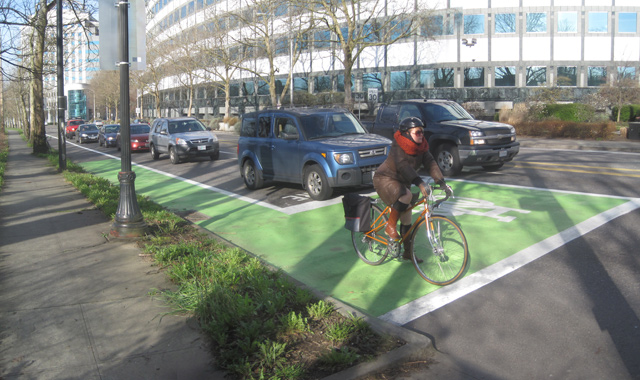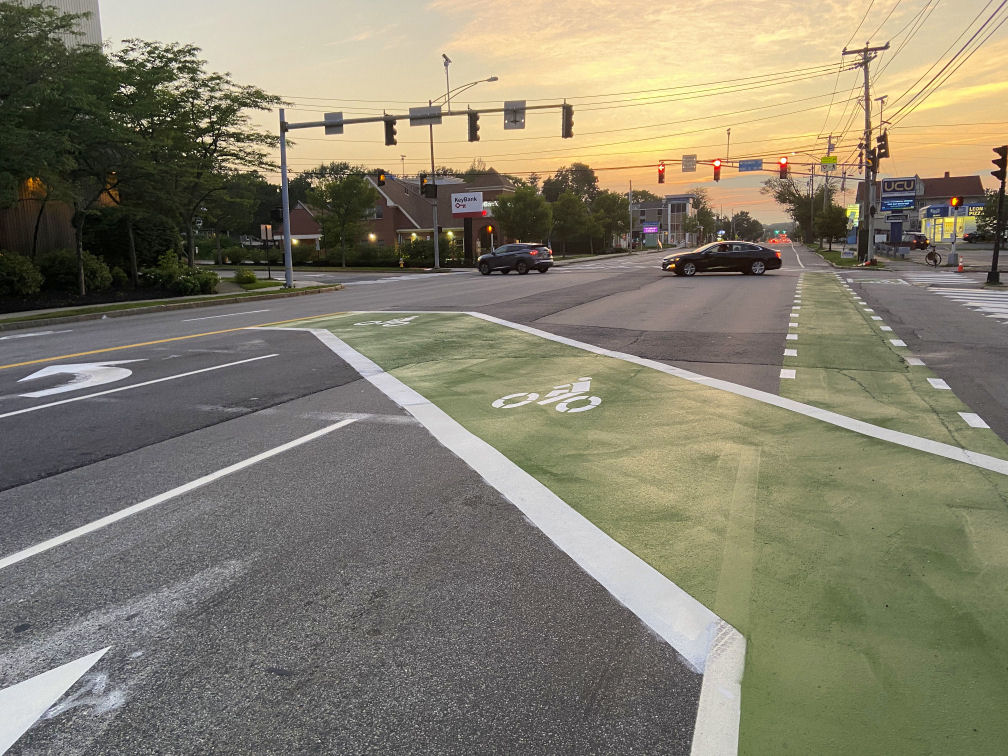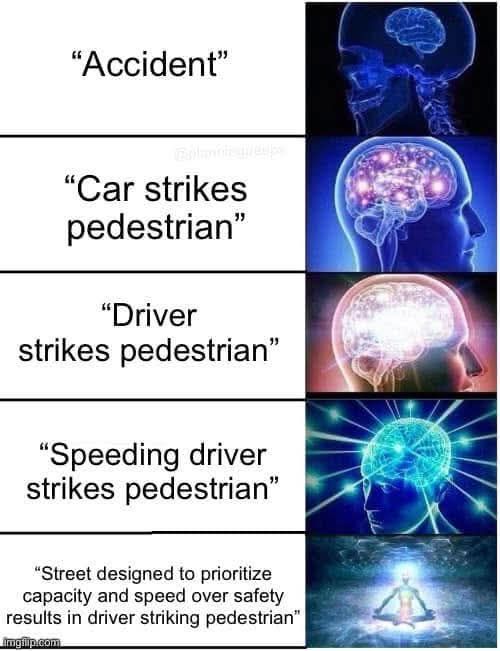
A fundamental principle of traffic engineering is that the road user who is required to yield right of way (in this case the motorist) must be able to see the one to whom yielding, unless a traffic signal establishes who must yield.
Bike boxes stand in stark conflict with this principle by having bicyclists swerve out in front of waiting motor vehicles at a traffic signal. Traffic engineers seem to have decided that the fundamental rule does not apply to bicyclists, as it does between motorists — or for that matter, between motorists and pedestrians.
The much-derided John Forester had an explanation, cited here:
Highway people had training deficiencies because of the overwhelming success of motorization. They never had to teach any traffic engineers how to drive. They never had to teach the theory of traffic safety — the theory was implicit in everyone’s driving knowledge. Therefore, these people never questioned the principles of the ‘bike safety training’ they had received. They didn’t recognize that it conflicted with the theory behind vehicle safety.
But in the case of a bike box, the disconnect is so stark and obvious, that I just have to wonder.
Research on bike boxes in Portland, Oregon showed that about 95% of bicyclists do not use the bike box. The bicyclists understand the risk of swerving into the bike box. They are less cautious about overtaking on the right to pull ahead of the first waiting motor vehicle, as also shown in the photo at the top of this article. Fatalities have resulted.

This bike box in the photo above has much worse problems than a square-across bike box, because bicyclists enter the bike box diagonally from behind. The Portland, Maine senior engineer’s explanation of this bike box is based entirely on the static geometry of the intersection. It pays no regard to the inability of motorists to see bicyclists to yield to them. The bicyclists approach outside the field of view of the right-side rear-view mirror. If the vehicle has windows behind the front row of seats, motorists could swivel their necks more than 90 degrees and see approaching bicyclists as long as there is no vehicle waiting in the next lane to the right. Without windows behind the right-side front door, or with passengers or cargo blocking the view, bicyclists approach unseen.
The bike box was painted in 2020 (also see this) and mercifully had largely faded away by November 2022, suggesting that it lacked full support of the city.
Here are the requirements for a bike box as stated in the MUTCD interim approval. The Portland one does not or may not comply with some of them, as described below.
A bicycle box shall be formed by an advance stop line placed at least 10 feet in advance of the intersection stop line.
Because the stop line is diagonal, it is not 10 feet ahead of the far side of the bike box. The left side of the stop line is nearly even with the right side of the front of the bike box, in each lane.
At least one bicycle symbol shall be placed within a bicycle box (see Attachments IA-18-1 and IA-18-2 for placement details).
This is in compliance.
Where a bicycle box is provided across multiple lanes of an approach, countdown pedestrian signals (see Section 4E.07 of the 2009 MUTCD) shall be provided for the crosswalk across the approach on which the bicycle box is located to inform bicyclists whether there is adequate time remaining to cross to an adjacent lane before the onset of the green signal phase for that approach.
I can’t tell whether countdown signals are at this intersection from the photo but in any case, there is no crosswalk across the approach on which the bike box is located. The lack of one reflects an understanding of the same problem that the design of the bike box ignores: pedestrians approaching from beside and behind waiting vehicles. There is a crosswalk across the far side of the intersection.
Turns on red shall be prohibited from the approach where a bicycle box is placed using a NO TURN ON RED (R10-11 series) sign.
I don’t see a NO TURN ON RED sign at the far side of the intersection. I also can’t tell from the photo whether right turns are permitted from the lane to the left of the bike box.
At least 50 feet of bicycle lane should be provided on the approach to a bicycle box so bicyclists will not need to ride between lanes to enter the bicycle box.
I can’t tell from the photo. Note that the MUTCD statement is defective in that a bike lane may be to the right of all the other lanes. It is a “should” rather than a “shall”, so it is not a firm requirement.
A STOP HERE ON RED (R10-6 or R10-6a) sign should be provided at the advance stop line defining the bicycle box with an EXCEPT BICYCLES (R3-7bP) word legend plaque below (see Attachments IA-18-1 and IA-18-2).
As of November 2022, there was none. What “stop here” would mean is unclear as the stop line is
Green-colored pavement (see Interim Approval No. 14) may be used within a bicycle box and the approach bicycle lane, where one is provided. A separate request for Interim Approval for green-colored pavement is required if the agency has not already received such an approval.
Has it? I can also add: the MUTCD diagram in the Interim approval does not show a diagonal bike box. This design was never contemplated. However, design is supposed to reflect engineering judgment. A facility which does not allow safe yielding reflects poor engineering judgment. What specific approval has the City of Portland received for this unusual and troubling design, if any?
Is the bike box swerve accommodated in Maine traffic law or Portland ordinances? I don’t think so.
Also, the MUTCD is authorized by the FHWA. The NACTO guide is not an official guide and does not reflect engineering standards.
I expect that the bike box will see very little use. Bicyclists will ether merge before turning left, or go to the two-stage turn queuing box at the far right side of the intersection. Either of those maneuvers is accepted and normal.
I also expect that motorists will regularly encroach into the bike box, and bicyclists will not use it, as at this one in Boston:

